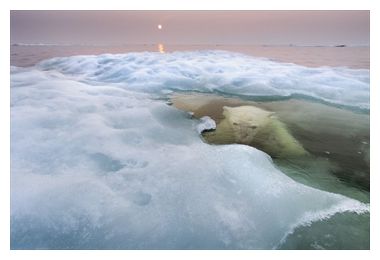
In separate studies published this week, research teams working in Barrow, Alaska announced two discoveries about the polar air: an unexpected process for depositing mercury pollution to land and sea, and the highest levels of molecular chlorine ever detected.
The chlorine finding, published in Nature Geoscience, is simply weird - it's too early to conclude what it means for the environment on a broader scale.
But the mercury finding, , is worrisome. Mercury is a potent neurotoxin that enters the atmosphere through coal-burning power plants and other industries, and can be carried far from its original source. When it enters an ecosystem, bacteria can transform it into highly toxic methylmercury and that builds up in wildlife; in humans, it has a host of harmful effects including neurological damage to babies in the womb.
The twin papers are another indication that the Arctic remains an enigma, especially as it changes in response to global warming.
"There's a lot left to learn - not just about the Arctic atmosphere but about atmosphere, ocean, sea ice, land, and snow," said Kimberly Strong, an Arctic expert and atmospheric physicist at the University of Toronto who was not involved in either research team.
"We're really just starting to pull together all the bits of the puzzle, and these two studies are contributing to that."
Both of the studies relate to a peculiar process that is one of the strangest things done in the midnight sun, at least when it comes to atmospheric chemistry. More than 20 years ago, scientists discovered that something weird was happening to mercury and ozone levels in the High Arctic air in springtime: in space of just hours they would suddenly disappear, only to return again hours later.
"At first we thought the instruments were broken," says Alexandra Steffen, an atmospheric mercury specialist at Environment Canada who was involved in those early experiments and the new study published in Nature. "Then it happened again. So then we started to really say, ok, what is going on here?"
The scientists discovered that bromine, a chemical component of sea salt found in the snow and ice, is released into the air where it reacts with sunlight and becomes volatile. It reacts with mercury and ozone, destroying the ozone and converting the mercury into a form that can be deposited onto earth.
For the new study published in Nature, Steffen and a team of researchers led by Christopher Moore and Daniel Obrist from the Desert Research Institute in Nevada set out to discover how sea ice dynamics affect this unusual chemistry.
They hauled a mercury-measuring instrument that was made in Toronto onto the frozen Chukchi Sea off the coast of Alaska, and then monitored what happened when air masses moved over channels of open water in the sea ice called "leads."
The usual mercury and ozone depletion events occurred. But then the levels of both substances would suddenly spike back up. It happened too quickly to be the result of new clouds of mercury pollution rolling in from across the sea.
The mercury and ozone were being sucked down from higher up in the atmosphere as a result of the "leads" in the sea ice. Leads expose the frigid Arctic air to warmer sea water, creating turbulence that churns the atmosphere above and draws down a fresh supply of air where the mercury and ozone have not been depleted yet.
That means there is more of both available to undergo the process of being destroyed, in the case of ozone, or deposited onto the earth's surface, in the case of mercury.
Climate change has radically altered Arctic sea ice dynamics, creating thinner seasonal ice that is more susceptible to the creation of leads. It's possible, the researchers conclude in Nature, that this process is increasing the overall mercury load in the Arctic.
The next step is to confirm that this happens elsewhere in the Arctic, says Obrist. "But this certainly has the potential to refuel the mercury deposition and increase it.
"A changing Arctic can have very unexpected consequences."
The chlorine study published in Nature Geoscience adds an interesting extra dimension to the story. A research team led by Greg Huey, an atmospheric chemist at Georgia Tech, went to Barrow to analyze bromine compounds in the Alaskan air.
But to their shock, the spectrometer also uncovered molecular chlorine in levels as high as 400 parts per trillion by volume (meaning for every trillion molecules, 400 were chlorine). Those are the highest levels reported anywhere in the world, the study says.
The data "bordered on incredible. We didn't believe it at first," says Huey.
Chlorine is not only highly reactive, but highly reactive with sunlight, and the levels were measured during the day. It's unclear where such a massive supply of chlorine is coming from, though likely its original source is sea salt.
Chlorine, like bromine, reacts with mercury, oxidizing it and depositing it on earth. It also destroys ozone and methane. Huey has just finished writing a proposal to study whether chlorine appears in the atmosphere in other parts of the Arctic. It's too early to say how chlorine may be affecting the mercury cycle in the north.
Even after 20 years of Arctic research, Steffen says, every trip north uncovers a new story.
"The Arctic is a rich and wonderful place, and I hope we make our way to learn what's going on and preserve it as best we can."
Source: Torstar News Service



If this process has held true throughout the glaciation/retreat cycles, it might be an indicator of where the poles were in times past. Sediments high in mercury compounds would be what one was looking for, if one is able to avoid igneous sources.